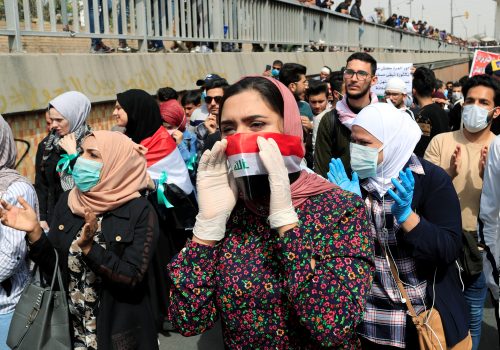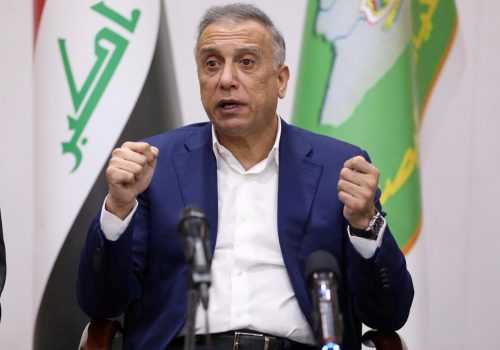The Sinjar agreement has good ideas, but is it a dead end?
This piece was updated on May 18.
On October 9, 2020, an agreement with minimal consultation from Sinjar’s local communities and little appetite for implementation was signed and introduced to the public. Under the auspices of the United Nations Assistance Mission for Iraq (UNAMI), the federal government in Baghdad and the Kurdistan Regional Government (KRG) signed a security and stability agreement for the district of Sinjar, aiming for reconciliation.
Sinjar is a Yazidi majority town in Iraq’s northern Nineveh governorate that suffered heavily during the Islamic State of Iraq and al-Sham (ISIS) onslaught in 2014, leading to genocide and other systematic abuses against its communities. With ISIS no longer a major threat, Iraq’s political disorder and skirmishes are what remain.
Sinjar is considered one of fourteen disputed territories claimed by both Baghdad and Erbil, which is defined by the rivalry between government and territory control. Additionally, as Sinjar shares borders with Syria’s al-Hasakah province to the northwest and Turkey’s Silopi province to the northeast, it remains in a regional quandary.
The security and stability agreement focuses on reconciliation through administrative changes, security, and reconstruction. Administratively, the agreement calls for the selection of a new mayor. Currently, Sinjar has two local governments: one appointed by authorities and located in Sinjar and the other being led by the mayor elected by the provisional council, who is currently operating in exile from Duhok. The agreement calls for Erbil-Baghdad to decide on an independent mayor, which remains pending.
In terms of security, the agreement calls for deportation of all armed groups and the appointment of 2,500 local security forces to Sinjar. However, the call for local police to re-control the area remains vital—absent implementation. The agreement also mentions the withdrawal of the Kurdistan Workers Party (PKK) from the Sinjar district. The PKK moved to Sinjar with the advantage of a security vacuum in 2014 as the ISIS attacks ensued. Soon after the establishment of the Sinjar Resistance Units (YBS), a political wing was founded under the Sinjar Democratic Autonomous Council and Yazidi Freedom and Democracy Party. With the PKK’s integration and the recruitment of Yazidis to the YBS to help with the area’s security, it created further obstacles to the group’s departure.
On reconstruction, the security and stability agreement urges forming a joint committee with the federal government and regional government to coordinate with the local administration in the Nineveh governorate for reconstruction. The agreement also aims to enforce stability, security, civil administration, and provide services and reconstruction to encourage the return of people who have been internally displaced (IDP) since 2014.
What has been done so far?
The security and stability agreement strides mediation between Erbil-Baghdad relations. However, five months on, it remains mostly on paper. In January, Special Representative of the Secretary-General for the United Nations Assistance Mission for Iraq, Jeanine Hennis-Plasschaert, called for speedy implementation of the agreement between both governments. As an initial step, the federal government deployed two brigades of the Iraqi federal police during the first month of the agreement’s implementation to checkmark security-related objectives. The fast deployment aimed to encourage Iraqi IDPs to return to their homes.
From a strategic regard in Iraq’s northeast, Sinjar has suffered drastically from the existence of different proxy and militia powers. In early March, the Kurdistan Democratic Party’s regional head, Kadir Kacak, stated “Regional powers want Sinjar to be part of Iran’s Shia Crescent.”
With the presence of the PKK and the Shia paramilitary group, the Popular Mobilization Forces (PMF) units in Sinjar—who are closely tied to Iran—the agreement’s implementation has become more formidable. According to Sheikh Shamo, KRG advisor for Yazidi affairs, around fifteen thousand PMF members were deployed to Sinjar by early March. Shamo stressed establishing new military bases on Sinjar Mountain, which was and still is controlled by the PKK. Recently, Turkish President Recep Tayyip Erdogan stated that his country would not allow Sinjar to become a second Qandil. In other words, he would not allow PKK forces—which Turkey views as a terrorist organization—to establish a second unmovable headquarters on Sinjar Mountain. Therefore, the PKK’s resistance and refusal to move may lead Turkey to start operations in Sinjar, making the agreement null and void.
The reality is that the implementation of the Sinjar agreement was not a straightforward operation. It lacked sequencing on what should be done first. However, undermining and outright ignoring local consultation set a bad precedent from the outset, leaving little optimism for Sinjar’s locals. So far, the agreement has failed to meet its objectives and expectations. Having said that, it remains the best way forward in bringing stability back to Sinjar and enabling the return of thousands of IDPs. If implemented, the Sinjar agreement may well become a healthy example for the rest of the areas disputed between the federal government and the KRG.
Other emerging issues that can derail the agreement from implementation include: disputes over the selection of a new mayor, the federal government’s lack of power in moving the PKK peacefully from Sinjar, the threat of the Turkish military’s operations in response, and the refusal of the PMF to withdraw from the area.
Now what?
Since the US invasion of Iraq in 2003, residents of the disputed areas have been caught between the tensions of both the KRG and the federal government with minimal power to influence or decide the faith of their areas in which they reside—or once did. The success of any agreement requires the will of all sides to turn written words into on-the-ground actions. A carefully tailored agreement that aims to return security, stability, and economic revival requires local actors’ engagement. Designing, signing, and working on an agreement without the community’s representation has only created further disillusionment. The absence of Yazidi leaders amplified further tensions between local engagers in response to Baghdad and Erbil. Members of civil society organizations and Yazidi elites signed a joint statement following the agreement in October 2020, stating the importance of the agreement toward addressing Yazidi problems while calling for bottom-up implementation.
As Shamiran Mako argues in a piece for Lawfare, short- and long-term conflict resolution is needed to solve the current impasse. In the short term, the engagement of the local community with their representatives is required for each step. Erbil and Baghdad need to compromise and work on the selection of a new mayor for Sinjar district. A bottom-up method needs to be introduced to the government so that community-oriented solutions can pave the way toward stabilization and settlement. Gradually there will be a need for a complete withdrawal of all the forces from Sinjar district and the community’s reintegration to secure its territory through local police.
Conversations between the federal government in Baghdad and the KRG with neighboring countries—Turkey and Iran—are integral in supporting the Sinjar agreement’s implementation to end any further instability. The uncontrollable surge of powers in Sinjar may bring about the next political and humanitarian catastrophe for Iraq if not managed properly.
Hanar Marouf is PhD candidate in Politics and international relations and a Millennium Leadership Fellow at the Atlantic Council.
Image: A displaced Iraqi boy from the minority Yazidi sect, who fled the Iraqi town of Sinjar, sells chicken at the Khanki camp on the outskirts of Dohuk province, July 31, 2019. Picture taken July 31, 2019. REUTERS/Ari Jalal TPX IMAGES OF THE DAY


